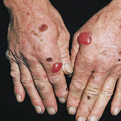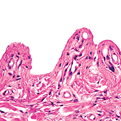Porphyria Cutanea Tarda
General Information
Porphyria cutanea tarda (PCT) is the most common type of porphyria, a group of diseases in which the production of heme is disrupted. PCT is due to a defective enzyme (uroporphyrinogen decarboxylase) in the liver. There are two forms of the disease, the more common acquired form that is triggered by nongenetic factors such as alcohol abuse, excess iron, certain hormones, and viral infections and an inherited form due to a condition arising from a mutation in the uroporphyrinogen decarboxylase gene. PCT causes sensitivity to sun exposure with exposed areas develop in severe blistering, dyspigmentation and scarring. The urine may have porphyrin pigments present causing a red to brown hue. Protection from sunlight is the main factor to minimize photosensitivity. Discontinuation of alcohol, iron and estrogen (if possible) is recommended. The therapeutic main goal is to reduce serum ferritin levels to a lower limit of the reference range. Phlebotomy (removal of blood) – up to 500 ml blood is removed every one to two weeks until the hemoglobin and iron levels drop to low normal levels. In patients in whom phlebotomy is not convenient or is contraindicated and in those who have relatively mild iron overload, oral chloroquine phosphate (125-250 mg PO twice weekly) or hydroxychloroquine sulfate (200-400 mg PO 2-3 times/wk), is often effective. Chelation with desferrioxamine is an alternative means of iron mobilization when venesections are not practical.
Epidemiology
Estimated at 1 case in 25,000-50,000 population in the United States
Etiology
Defective liver enzyme, uroporphyrinogen decarboxylase (UROD)
Pathogenesis
Increase porphyrins in skin resulting in photosensitivity
Clinical
Fragile skin on back of hands and forearms with features including sores, blisters and tiny cysts
Histology
Subepidermal bullae with minimal dermal inflammatory infiltrate and dermal papillae protruding upward into the blister cavity.
Bibliography
1. “Porphyria Cutanea Tarda” (Online). February 2007. http://www.emedicine.com/DERM/topic344.htm (visited: April 2, 2008) 2. “Porphyria cutanea tarda” (Online). http://dermnetnz.org/systemic/porphyria-cutanea-tarda.html (visited: April 2, 2008)
Download PDF
![]() Porphyria Cutanea Tarda
Porphyria Cutanea Tarda


